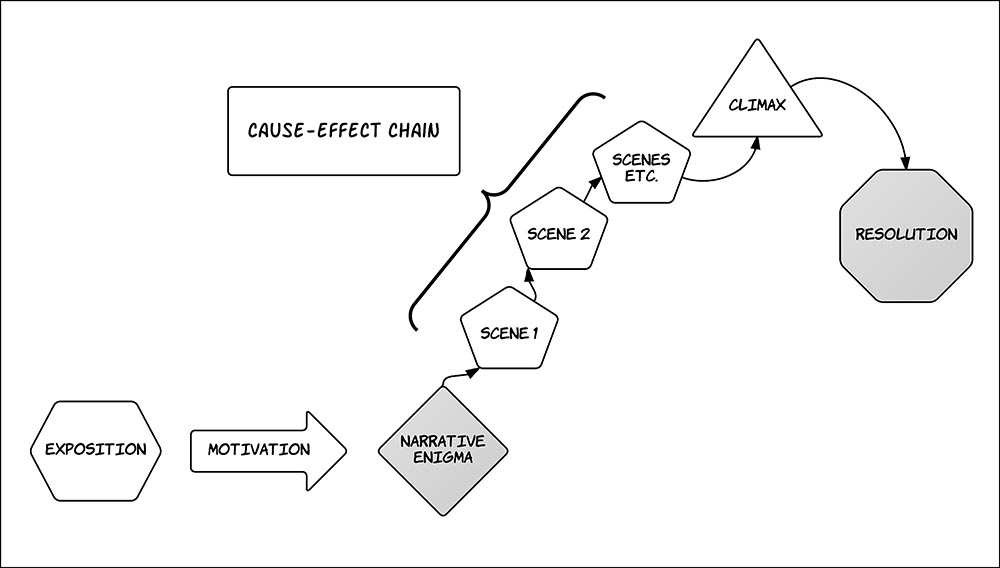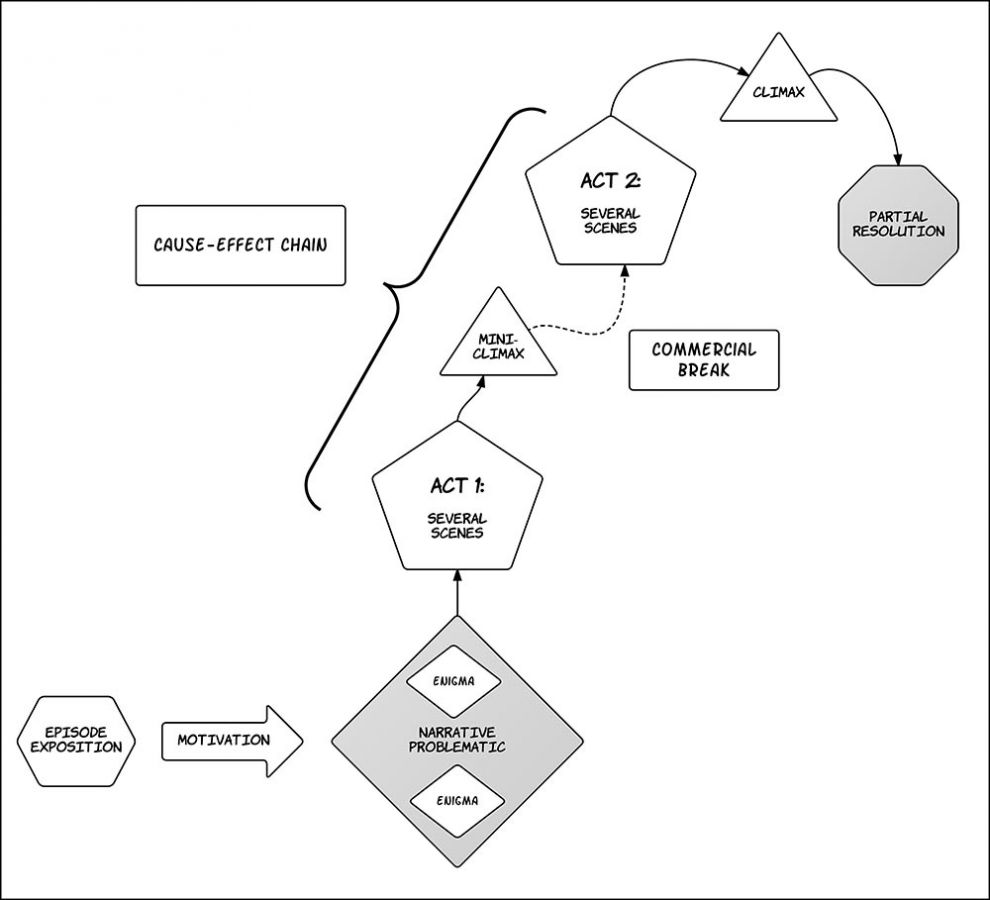Narrative Structure (Discussion)
From Screenpedia
Revision as of 19:32, 1 September 2020 by Jeremy Butler (talk | contribs) (→Returning to "discourse")
- Sample from today's e-newsletter:
- "Fifty percent of consumers say online TV platforms are their first stop for TV viewing, surpassing traditional pay TV, according to new data from Hub Entertainment Research. In particular, the company notes, Netflix has continued its steady climb as consumers’ TV “default,” and live TV has continued its steep drop over the past four years."
Classical Hollywood cinema
Choose a classical film that everyone in your group has seen. Explain how it fits the classical implementation of:
- Single protagonist
- Exposition
- Motivation
- Narrative enigma
- Cause-effect chain
- Story time versus screen time--in terms of duration and order
- Climax
- Resolution
Break-out group examples
- G1: Cinderella (typed by Rachel)
- Single Protagonist- Yes
- Exposition- Cinderella wakes up, and we meet her and her animal friends
- Motivation- To attain independence from her family
- Narrative Enigma- Will Cinderella ever be free of her evil family?
- Cause-effect Chain
- The prince needs a wife, so he holds a ball
- All women of the kingdom are invited
- The stepmother says that Cinderella can attend if she completes her chores
- Animals help make her dress
- Evil Stepsisters destroy her dress
- The fairy godmother appears and preps Cinderella for the ball but says she must leave by midnight
- Cinderella goes to the ball and the prince falls in love
- Climax- Cinderella runs away from the ball as the clock strikes midnight, leaving behind one glass slipper
- Resolution- The prince searches for the woman from the ball; the glass slipper fits Cinderella perfectly; she and the prince get married #happilyeverafter; Cinderella finally has freedom from her family
- G2: Up (typed by Emily)
- Single Protagnoist: Carl
- Exposition: the beginning reflection on on his life with Ellie
- Motivation: fulfill his wife's dream of going to Paradise Falls
- Narrative Enigma: Russell, a boy scout, comes and joins Carl on his adventure (unexpectedly) eventually, they gain a dog named Doug, and eventually a bird
- Cause and Effect Chain: they get the dog, then the bird comes, and then they find Charles Muntz and the Spirit of Adventure
- Climax: Carl fights Muntz in hopes to save the bird and his newly found friends
- Resolution: Russel gets his badge for helping Carl and Carl gets to spend time with his newly found friends and dog
- G3: Iron Man (typed by Emmy)
- The protagonist is Tony Stark and he is the solitary main character of the film.
- The main exposition is given in one of the beginning scenes at an awards ceremony where they play a video detailing his history and why he has been selected.
- His motivation is that he is seeking fulfillment. At first, he tries to satisfy this need with women, gambling, and buying objects. As the movie progresses, however, he turns away from those to realize that he wants to help others and that being a better man makes him feel complete.
- The narrative enigma throughout the movie is if he will succeed in becoming a better person or if he will revert to his old selfish practices.
- The cause and effect chain is large, but, essentially, Tony is arrogant and strong-willed, which causes his second in command at the company to want him out of the picture. The man then enlists people to kill Tony, which causes them to recognize and kidnap him instead, sparking a chain of events that has a mini climax when Tony works with his fellow prisoner to escape the caves. When he returns there is another chain of cause and effect as he struggles to help those he saw in need, causing his second in command to want him dead all the more.
- This conflict culminates in the climax where Tony faces the antagonist who has been trying to get him to sell more weapons rather than help people. This villain represents who Tony would be if he had made different choices throughout the movie.
- The film ends with Tony defeating the villain and announcing to the world that he is the hero they have heard about, thus claiming the actions that have defined him as a good man.
- G4: The Lion King (typed by Jessica)
- Single Protagonist - Simba
- Exposition - Introduces characters in the African wilderness and establishes their personas. For example, Simba is established as brave, mischievous, and admiring of his father. On the other hand, Scar is shown to be cruel and cunning.
- Motivation - The action's catalyst is Scar murdering Mufasa
- Narrative Enigma - Will Simba take the throne and save the kingdom?
- Cause-Effect Chain - Scar kills Mufasa and then makes Simba feel guilty so that he runs away. Since he runs away, he meets Pumba and Timone who then keep him alive but away from the kingdom. But Scar taking over causes Nala to come and find Simba and convince him to return and challenge Scar for the throne.
- Climax: Battle between the lions and the hyenas, which ultimately results in Simba's success and Scar's death.
- Resolution - Simba takes over the throne and helps restore the kingdom. He and Nala start a family and his mother is safe once again.
The television series
Break down the "The Vartabedian Conundrum" episode from The Big Bang Theory (December 8, 2008).
- How many scenes does it have?
- Nine, if you don't count the "cold open" and the "tag."
Explain how it does or does not exemplify conventional television-series narrative structure. Refer to these scene-by-scene screenshots and the episode's screenplay for specific examples.
- G2: Multiple protagonists
- It may help to refer to other episodes in the program, if you've seen them.
- G3: Exposition and motivation
- G4: Narrative problematic
- It may help to refer to other episodes in the program, if you've seen them.
- G4: Cause-effect chain
- G1: Climax
- G1: Resolution
Returning to "discourse"
- What are the different discourses or worldviews shown in TBBT? How would you describe its polysemy?
- What values does it attach to professors/engineers?
- Are there gender stereotypes at play?
- How do the young women we've seen compare/contrast in terms of gender roles and their relationships with the shows' men?
- Penny and Stephanie (Big Bang)
- Helen (Andy Griffith Show)
- Stevie (Schitt's Creek)
- How do the young women we've seen compare/contrast in terms of gender roles and their relationships with the shows' men?
- Is there a final meaning (a "message" or "moral") that the show presents to the viewer?
- Do you agree with it?
The television serial
- Select a serial that most of your group watches.
- Contrast the serial with the series. Aside from the obvious lack of resolution in the serial, name (and be prepared to explain) three differences between the two in terms of the narrative elements listed above.
- Contrast the serial with the series. Aside from the obvious lack of resolution in the serial, name (and be prepared to explain) three differences between the two in terms of the narrative elements listed above.
Bibliography
- Jeremy G. Butler, Television: Visual Storytelling and Screen Culture (New York: Routledge, 2018).
- TV Tropes: listing of numerous narrative conventions.
External links
- The Big Bang Theory, "The Vartabedian Conundrum" shot lists
- The Big Bang Theory, "The Vartabedian Conundrum" screenplay

